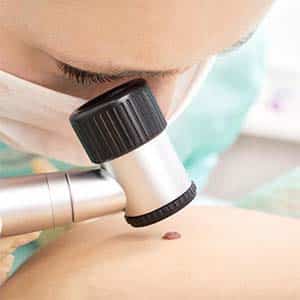Melanoma is the most serious type of skin cancer. It can sometimes be life threatening. It starts in skin cells called melanocytes. These are cells that make melanin, the source of your skin’s color. Melanin also serves to protect deeper layers of your skin from the sun’s harmful ultraviolet rays.
If your skin gets too much ultraviolet light, the melanocytes can begin to grow abnormally and become cancerous. This condition is known as melanoma.

In men, melanoma most often appears on the upper body, between the shoulders and hips as well as on the head and neck. In women, it often develops on the lower legs. In darker skinned people it may show up under the fingernails or toenails, on the palms of the hands or the soles of the feet. These are common places to look but really, melanomas can appear anywhere on your skin. That’s why it’s essential to regularly examine your skin for new moles or changes in existing moles.

There’s good news though. If melanoma is found and treated in its early stages, the chances of recovery are very good. If overlooked, melanoma can grow deeper into the skin and metastasize to other parts of the body. By that point, it becomes harder to treat. Therefore, it’s important to check your skin every month.
Here’s some tips on how to do so:
- Familiarize yourself with all moles, freckles and other marks on your skin.
- Stand in front of a full-length mirror and utilize a hand-held mirror as well to fully examine all areas of your body including your lower back, buttocks, back of shoulders, and backs of thighs.
- Note any unusual sore, lump, spot, marking or change to an area of your skin. Is it scaly or crusty? Itchy or tender? Red and swollen? Pay particular attention if it oozes or bleeds.
- Look especially for spots on your skin that are changing or have changed in size, shape or color over the past few months. These warrant a visit to your doctor.
If you have a history of melanoma or are at risk because a job or leisure pursuit results in your having prolonged exposure to ultraviolet rays, it’s important to see a dermatologist once a year.

 Payam Saadat, MD
Payam Saadat, MD